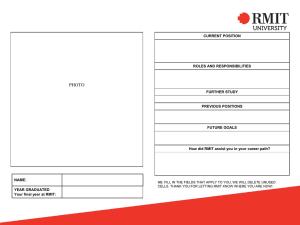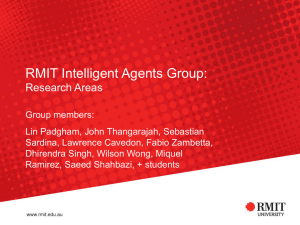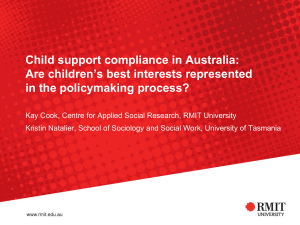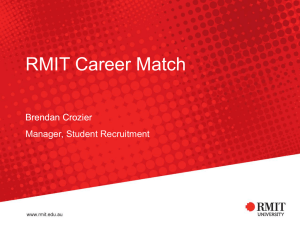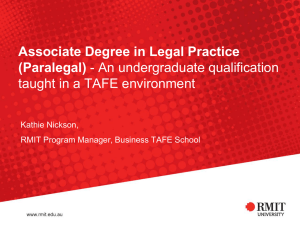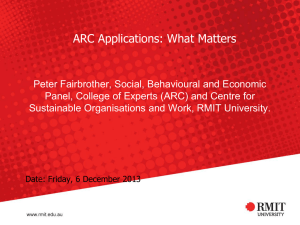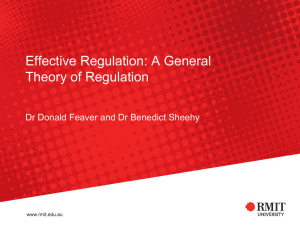power_resistance_and_decision_making
advertisement
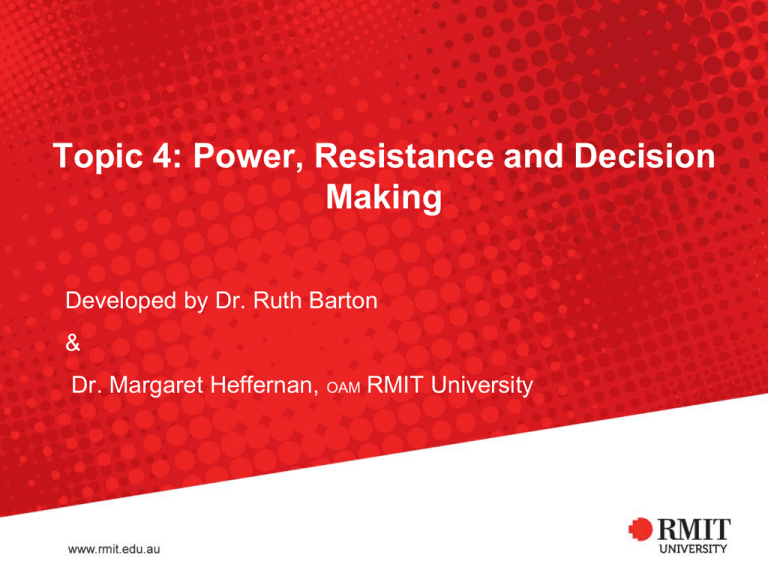
Topic 4: Power, Resistance and Decision Making Developed by Dr. Ruth Barton & Dr. Margaret Heffernan, OAM RMIT University Aims of the lecture Questions of power Hoe power works; 4 faces of power Resistance and control Types of resistance Decision making Theories of decision making; factors that enhance and limit decision making RMIT University©2012 2 Questions of Power Who has power? How is influence achieved? What is power? Several dimensions and bases RMIT University©2012 How is power obtained in organisations? POWER What alternative theories and perspectives are there? What of resistance? Another form of power? 3 How Does Power Work in Organisations? Organisations are hierarchical RMIT University© Power as the ability to control social interaction What is Power? Normative (most rational way of organising power) Realpolitik (how does power actually operate) An individual capacity? Two broad traditions OB blind towards power Property of the person or collective? Power as the prerogative of wise or wealthy men? RMIT University©2012 (Source: Thompson and McHugh 2009:256) 5 Power in Mainstream Theory Bases of power ► Reward ► Coercive ► Referent ► Legitimate ► Expert (French & Raven 1959) RMIT University© Trend spotting as Power information power in the advertising industry Control over information flow legitimate power More power to those who can help firms cope with uncertainty in contemporary business Power : Mainstream Theory • The Four ‘Faces’ of Power Economic ►Coercion ► Manipulation Coercive Ideological (Runciman 1999) RMIT University© ► Domination ► Subjectification (Fleming and Spicer 2007) 1st Face of Power: Coercion Direct coercion getting another person to do something that might not have been done. RMIT University© 2nd Face of Power - Manipulation ►Of agendas: ‘behind the scenes’ politicking 3 processes ► Anticipation of results ► Mobilisation of bias ► Rule and norm making RMIT University© ►Exclusion from decision making authority ►Power as manipulation: There is no direct exercise of power but an implicit shaping of issues considered important or irrelevant. 3rd Face of Power - Domination ►Over the preferences and opinions of participants ►Power that shapes our preferences, attitudes and political outlook ►Used in the design and implementation of paradigmatic frameworks ►Forms of life e.g. profit ►Ideology ►Technical rationality RMIT University© 4th Face of Power - Subjectification ►People are moulded with certain understandings of themselves and the world around them ►The organisation moulds people into a certain type ►Use knowledge to produce compliance ►Culture of the customer RMIT University© “A wide range of behaviour – from failure to work very hard or conscientiously, to not working at all, deliberate output restriction, practical joking, pilferage and sabotage.” (Ackroyd and Thompson, 1999 cited in Fleming and Spicer, 2007) “Resistance constitutes a form of power exercised by subordinates in the workplace.” (Collinson, 1994 cited in Fleming and Spicer, 2007) Resistance RMIT University©2012 12 Resistance as Refusal ► 1st face of power is coercion ► Resistance is refusal to do what the person in the position of power tells him / her to do ► Aim is to block the effects of power by undermining the domination rather than changing it RMIT University© Resistance as Voice ►2nd face of power operates through nonparticipation ► Resistance is to gain access to power in order to express voice ►Internal: interest groups, trade unions ►External: social movements ►Sabotage RMIT University© Resistance as Escape ► 3rd face of power is domination ► Escape is to mentally disengage from the world of work ► Tools are ►Cynicism ►scepticism ►dis-identification RMIT University© Resistance as Creation • 4th face of power is subjectification • Involves using domination to create something that was not intended by those in authority • May make use of parody e.g. Union newsletter RMIT University© “A decision is often defined as a product of decision making processes. Recent researchers argue that managers often seek to avoid making decisions or obscure them, often to avoid accountability for courses of action that are subsequently seen as misguided.” Decision making RMIT University©2012 Linstead & Fulop 2009: 669 17 Traditional decision-making theories and ‘choice’ Decision making: a response to a situation requiring a choice. Unitary approach Pluralist approach RMIT University©2012 • A general agreement about organisational goals and the best means to achieve them. • Emphasises conflict & power struggles between individuals & coalitions in organisations in circumstances where participants have substantial knowledge and information. Linstead & Fulop 2009: 671 18 Types of ‘choice’ Clear choice Competing choice Choice avoidance Choice suppression RMIT University©2012 • Which two products to adopt. Straightforward • Alternatives of improving profitability • Occurs when issues arising require resolution • When information is distorted or suppressed Linstead & Fulop 2009: 672 19 Types of decision processes Sporadic Fluid decision Constricted decision Informal Will suffer from delays Flow, formally channelled, Speedy & predictable Narrowly channelled, technical information Information from various sources of expertise Time delays Information from fewer sources Fewer delays Decision made by experts RMIT University©2012 Linstead & Fulop 2009: 671 20 Models of decision Making Rational • Decisions are made after careful evaluation of alternative courses of action Administrative / Bureaucratic • Questions whether managers are capable of making fully rational decisions Garbage-can Political RMIT University©2012 • Introduces the idea that decisions are really problems looking for solutions Examines the role of powerful decision making groups (‘dominant coalitions’) and why many decisions are really ‘nondecisions’ Source: Thompson and McHugh 2009,Table 18.1: 273-4 21 The rational decision model Recognition and definition of a problem Assumptions ► Problem clarity Search for alternative courses of action ► Known options ► Clear preferences ► Constant preferences Gathering and analysing data ► Maximum pay-off ► No time or cost constraints Identification and application of choice criteria Evaluation of alternatives in relation to choice criteria RMIT University© ► Outcome will be rational Implementation of decision (Bratton et al. 2010: 411; Linstead & Fulop 2009:674; Nelson et al. 2012:150 ) Bureaucratic / administrative model Based on the actual behaviour of decision makers Assumptions Managers: There are cognitive or mental limits to human rationality Decision making is governed by bounded rationality Influence of nonrational elements in humans Satisfices RMIT University© ► Select the first satisfactory alternative Are comfortable making decisions without determining the alternatives ► Make decisions by short cuts or heuristics (managers make decisions on what has worked in the past) ► Satisfice – because of cost of ‘best choice’ Decision made on ‘best in the circumstances’ (Bratton et al. 2010: 411; Linstead & Fulop 2009:676; Nelson et al. 2012:151 ) Garbage-can decision model Difficulty Organised anarchy ► Failure to account for the political activity of participants who encourage conditions of organised anarchy, or who exploit them for particular advantage. Not clear if an issue is a problem, or a solution to a problem Reaction to circumstances Total demands on the decision makers at the time RMIT University© (Linstead & Fulop 2009:683) Implementation of decision Political decision model Recognises the role of conflict and conflict resolution in the decisionmaking process Difficulty Pluralistic in nature Recognises the role of stakeholders in the organisation Decision making is about reconciling stakeholders interests RMIT University© (Linstead & Fulop 2009:685) ► The pluralist approach does not explain how decisions can be made or avoided in organisations because of the influence or pressure of external groups who may form part of a dominant coalition. Implementation of decision ‘Z’ Model of Decision Making Look at the facts and details Sensing Intuition What are the facts? Be specific and realistic. List all relevant details. Be clear. Can it be analysed objectively? Consider the # consequences of each alternative # cause and effect of each action If you were not involved, what would you suggest? RMIT University© What alternatives do the facts suggest? Let your imagination run wild. Brainstorm. Consider various solutions Thinking Feeling What impact will it have on those involved? Is it something you can live with? How do you feel about the action? What hunches do you have about others’ reactions? Pfeffer’s Four Organisational Decision-Making Models DIMENSION RATIONAL (Unitary) BUREAUCRATIC (unitary) GARBAGE CAN (pluralist) POLITICAL POWER (pluralist) PREFERENCES & GOALS Consistent among participants Reasonably consistent Unclear, ambiguous, may be constructed afterwards to legitimise actions Inconsistent, diverse or conflicting goals & preferences POWER & CONTROL Focuses on hierarchical authority Less centralised , still legitimate authority Very decentralised, anarchic; power is also recognised Shifting coalitions &interest groups who have power but not necessarily authority DECISION Orderly, rational Procedural rationality embodied in programmes &standard operating procedures EXPECTED RESULTS & OUTCOMES Maximisation & optimisation Follow from ‘satisficing’ mode Unclear, ambiguous Power & stabilisation of demands INFORMATION Extensive &systematic information gathering Reduced by the use of rules & procedures information Haphazard collection & use of information Information used & withheld strategically Stability, fairness Playfulness Conflict & power struggles among relatively equal opponents PROCESS REQUIREMENTS RATIONALE Efficiency &effectiveness in achieving agreed-to performance criteria Ad hoc (Adapted from Table 14.2, p.686 in Linstead et al. 2009) Disorderly, characterised by push & pull of interest groups Escalation of Commitment Limitation that all decision making models share Unwillingness to abandon a bad decision, or continuing The desire to win is a motivation to continue to support a failing course of action, even to escalate when substantial costs are incurred RMIT University©2012 Source: Nelson et al. 2012:151 28 Techniques of decision making Types of decision Traditional decision-making techniques Modern decision-making techniques 1.Programmed ► Routine, repetitive decisions; organisation develops specific processes for handling them. ► Low uncertainty and low ambiguity ► Habit ► Clerical routine: standard operating procedures, policies, manuals ► Organisation structure – know your place ► Systems of sub-goals ► Well-defined information channels ► Operations research mathematical models, computer simulations ► Electronic data processing ► Management information systems 2. Non-programmed ► Judgment, intuition , ► One-shot, illcreativity structured novel policy ► Rule of thumb (by top decisions. management) ► Handled by general non-routine problemsolving processes. ► High uncertainty and ambiguity. RMIT University© Heuristic (problem solving) techniques applied to: ► constructing computer models ► brainstorming ► counter-planning ► simulation (Linstead & Fulop 2009:Table 14.1: 677) Influences of Decision Making Individuals differ in risk behaviour Risk, risk aversion Enablers and barriers to creativity Personality, attitudes, values Organisation Environment Influences 4 stages: Preparation Incubation Illumination Verification RMIT University©2012 Creativity Intuition (Source: nelson et al. 2012: 153) Ability to make judgment about a situation based on a ‘hunch’. 30 Group Decision making Synergy = 1 + 1 = 3 Advantages Disadvantages More knowledge and information Pressure to conform Greater understanding of the decision Domination by one forceful member Member involvement Time required to make a decision RMIT University©2012 Nelson et al. 2012: 157 31 Levels of organisational decision-making behaviour Level of analysis Theoretical Key issues Approaches Theories of Effects of power Organisation organisation and conflict power, conflict and decision making Group Individual RMIT University© Constraints 1.Multiple ongoing tasks 2.Historical precedents 3.HRM systems 4.Time constraints 1.Group conformity, group dynamics, group size, and networks Effects of group dynamics, individual perceptions and behaviours 1. Group norms 2. Group think 1.Informationprocessing theory 2. Cognitive psychology 1.Information overload 2.Personal biases 1.Information processing failures 2.Perceptual biases 3.Intuition and emotion 4.Escalation of commitment Negative factors arising from group cohesiveness Groupthink Moral judgment and reality testing are suspended RMIT University©2012 Often occurs with high risk decisions in high-status groups with dominant leadership Source: Thompson and McHugh 2009:375 High stress conditions and threats to selfesteem 33 Symptoms of Groupthink • Conform and reach consensus • Unpopular ideas may be suppressed • Members who oppose the group are stereotyped as weak, evil or stupid. Leads members to be convinced of the logical correctness of what they are dong and ignore the ethical or moral consequences of decisions. RMIT University©2012 Illusion of invulnerability Pressure on individuals Group consensus Belief in the inherent morality of the group • Excessive optimism and risk taking • Group believes it cannot make a bad decision Leads to discounting warnings and negative information. An illusion of unanimity emerges Self-censorships of any deviation from group norms. Wood et al. 2010 : 103 34 Avoiding Groupthink Can be avoided with some effort Invite Interaction consultants Develop with other and others alternative to challenge groups plans the group Leaders need to be reflexive to assess their behaviour and stay impartial RMIT University©2012 Source: Thompson and McHugh 2009:375 35 Group Polarisation The tendency for group discussion to produce shifts toward more extreme attitudes among members. Can be disastrous RMIT University©2012 If individuals are leaning towards a dangerous decision they are likely to support it more strongly following discussion. Source: Nelson et al. 2012:160 36 Minimising Bias and Errors in Decision Making Brainstorming • Generation of free flowing multiple ideas • Computer mediated brainstorming Nominal group technique • Variation of brainstorming , independent contribution Stepladder technique • Discussion with two initial members, then additional members added until all group members have joined the discussion Delphi technique Structured team decision-making process of pooling the collective knowledge of subject experts RMIT University© Bratton et al. 2010 :425 References • Bratton, J, Sawchuck, P, Forshaw, C, Callinan, M, & Corbett, M 2010, Work and Organization Behaviour, 2nd edn, Palgrave MacMillan, UK. Chapter 15: Decision Making and Ethics, pp.407-432 • Clegg, S, Courpasson, D and Phillips, N (2007) Power and Organisations, London: SAGE. • Edwards, P and Wajcman, J (2005) The Politics of Working Life, OUP: Oxford. • Fleming, P and Spicer, A (2007) Contesting the Corporation: Struggle, Power and Resistance in Organisations, Cambridge: Cambridge University Press. • Haslam, SA, 2004, Psychology in organisations: the social identity approach, 2nd edn, Sage London. Chapter 6: Group decision making, pp.99-119 • Knights, D (2009) ‘Power at Work in Organisations’, in Alvesson, M, Bridgman, T and Willmott, H (eds) The Oxford handbook of Critical Management Studies, Oxford: OUP. • Linstead S, Fulop, L, Lilley, S 2009, Management and Organization: A critical text, 2nd edn, Palgrave MacMillan, London. Chapter 14: Decision making in organisations, pp. 667-708 • Nelson, DL, Quick, JC, Wright, S,& Adams, C 2012, OrgB Asia-Pacific Edition, Cengage, Sydney. Chapter 10: Decision making by individuals and groups, pp. 148-164 • Thompson, P, & McHugh, D, 2009 Work Organisations: A critical approach, Palgrave Macmillan, London. Chapter 24: From groups to teams, pp. 369-387 RMIT University©
